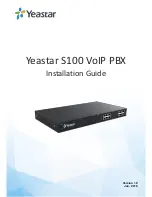
QX1000 Manual II: Administrator's Guide
Administrator’s Menus
QX1000; (SW Version 5.3.x)
113
Number of Discarded Symbols
requires the number of
symbols that should be discarded from the beginning of the
routing pattern. The field should be empty if digits do not need to
be discarded. Only numeric values are allowed for this field,
otherwise the error message “Error: Number of Discarded
Symbols is incorrect - digits allowed only” will appear.
Prefix
requires entering the symbols (letters, digits and any
characters supported in the SIP username) that will be placed in
front of the routing pattern instead of the discarded digits. The
following tags can be used for this field:
•
<callerid:range> - used to apply the complete or a part
of caller ID (the caller’s number detected during the call) as
a prefix. For example, <callerid:1-3> indicates that the first
3 digits of the caller ID will be considered as a prefix,
<callerid:3-end> indicates that the caller ID from its 3
rd
digit
and up to the end will be applied as a prefix. This tag can
be used in combination with other digits at the beginning or
at the end, as well as with wildcards.
Fig. II-195: Call Routing Wizard - page 1
•
<dialednum:range> - used to apply the complete or a part of dialed number (the number dialed by the caller to place a call) as a prefix. For
example, <dialednum:1-3> indicates that the first 3 digits of the dialed number will be considered as a prefix, <dialednum:3-end> indicates that
the dialed number from its 3
rd
digit and up to the end will be applied as a prefix. This tag can be used in combination with other digits at the
beginning or at the end, as well as with wildcards.
The syntax aaa,,,bbb in the
Prefix
field allows for two-stage dialing. The aaa and bbb are the numbers to call; bbb can also be a series of digits to
inject; a comma indicates a delay of one second. The syntax can be applied to include more call destination numbers separated by time intervals. A
two-stage dialing allows successive numbers to be dialed one after another with a delay in-between. For example, 11,,,11018 will call 11, wait until
the call is established, wait for three seconds and then dial 11018. The capability of automatically dialing successive numbers allows the caller to
bypass the IVR system on the call path and establish a direct call. The two-stage dialing is available for PBX and ISDN destination types.
Suffix
requires entering the symbols (letters, digits and any characters supported in the SIP username) that will be placed in the end of the routing
pattern. For example, if the routing
Pattern
is 12345, the
Number of Discarded Symbols
is two, and the
Prefix
is 909 and
Suffix
is 0a, the final
phone number will be 9093450a.
Destination Type
gives you the option to select the destination type. The following destination types are available:
•
PBX - local calls to QX1000’s extensions
•
PBX-Voicemail
-
calls directly to the voice mailbox of the local PBX extension
•
PBX-Intercom - local calls to PBX extensions with the request of Intercom service (see Manual III – Extension Users Guide)
•
SIP – calls through a SIP server
•
SIP_Tunnel – calls through a SIP tunnels established (see
•
IP-PSTN – calls through the IP-PSTN provider to the remote PSTN global telephone network
Metric
allows entering a rating for the selected route in a range from 0 to 20. If a value is not inserted into this field, 10 will be used as the default. If
two route entries match a user’s dial string, the route with the lower metric will be chosen.
The
Description
text field requires an optional description of the routing pattern.
The
Filter on Source / Modify Caller ID
checkbox selection allows limiting the functionality of the current route to be used by the defined caller(s)
only. If this checkbox is enabled, source caller information (
Source Number Pattern
,
Source Type, Source Host
, etc.) will be required later in the
Call Routing Wizard
. This option is enabled by default.
The
Set Date / Time Period(s)
checkbox selection allows you to define a validity period(s) for current routing patterns to take place and to define
pattern date/time rules. When this checkbox is enabled, the
Call Routing Wizard
- Page 5 will be displayed.
Set Tracing / Debug Options on This Rule
checkbox is used to switch events notification on the certain execution results of the corresponding
routing rule. When this checkbox is enabled, the
Call Routing Wizard
- Page 6 will be displayed.
Require Authorization for Enabling/Disabling
checkbox is used to enable administrator’s password authentication when enabler/disabler keys are
configured for the routing rule. The service can be used locally from the handset (see Feature Codes in Manual III - Extension Users Guide) or
remotely from Auto Attendant (see Auto Attendant Services in Manual III - Extension Users Guide). When this checkbox is selected, administrator’s
password will be requested to enable/disable the certain routing rule(s). If the administrator’s password has been inserted incorrectly for 3 times, no
status changes will be applied to any of the routing record(s), even to those which have no authorization enabled.
Enabler Key
and
Disabler Key
text fields request digit combination which should be dialed from the handset or Auto Attendant to enable or disable
the certain routing rules in the Call Routing Table. You can set the same Enabler/Disabler Key for multiple routing rules (the same key may be used
as enabler for one routing rule, and as disabler for another one) - this will allow managing several routing rules with the single key.




































